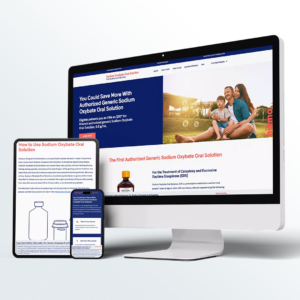What Makes a Pharma Ad Worth a Doctor’s Time?
Doctors scroll fast. Regulations change faster. And yet, pharma ads keep flooding their feeds. So what separates the ones that actually earn attention from those that get ignored? Let’s break down the art and science of creating healthcare professional (HCP) ads that connect, comply and truly make an impact.
If you’re in pharmaceutical marketing, September probably felt like a wake-up call. The FDA’s Office of Prescription Drug Promotion (OPDP) issued thousands of letters citing misleading ads,1 and suddenly, every marketer was asking the same question: “Are we next?”
The stakes have never been higher.
Pharmaceutical ad spending hit $19.45 billion in 20242, saturating the same digital spaces where doctors and patients already spend their time. Yet, primary care providers are stretched thin, facing ongoing pressure to do more with less time and reporting a growing mismatch between appointment lengths and workload demands.3
At the same time, regulator enforcement is tightening. After just one FDA warning letter in 2023 – and none in 2024 – the sudden wave of thousands this past September marks a clear shift from years of relative leniency to active oversight.1
In this climate of record ad spend, limited physician bandwidth and heightened scrutiny, pharma marketers can no longer rely on business-as-usual approaches. They need a consistent, compliant framework for developing campaigns that cut through the noise, educate effectively and withstand regulator review.
So how can your team rise to that challenge? Let’s explore how to create pharmaceutical ads that achieve impact and compliance.
Smarter Targeting Actually Saves Time
It’s tempting to just filter by specialty or job title. But not every doctor with the same specialty has the same patient mix, prescribing authority or influence. Two cardiologists might both treat heart failure, but one might focus on elderly patients while the other specializes in younger athletes. Your messaging should reflect that difference.
A smart targeting strategy starts with your brand’s goals and layers in richer context like:
- What hospital systems they work with and what’s on the formulary
- Prescribing patterns and patient volume
- Geographic location and patient demographics
- Conferences they attend or continuing education courses they complete
- How they use electronic health records
When you align your creative strategy with deeper insights, you not only reach the right physicians, you respect their time. The result is advertising that feels relevant, not repetitive and builds credibility with every impression.
Engaging Without Overwhelming
Clarity is critical in the crowded HCP advertising space. Doctors don’t have time to decode your message. They need to instantly see whether your product is relevant to their practice.
Here’s what I’ve learned works best:
- Call out your audience: Mention the specialty upfront. Doctors notice when an ad speaks directly to them.
- Lead with the indication: Make it clear which patients or conditions your product addresses.
- Give your ISI room to breathe: It’s not glamorous, but it’s essential for both compliance and credibility. Dedicate about one-third of your digital ad space for the ISI and make it readable.
- Keep it simple: Stick to one clear claim, one indication and one call to action. Think “See prescribing info,” “Explore clinical data” not a laundry list of options.
- Blend education with promotion: Share clinical data, treatment guidelines or helpful resources. Doctors appreciate helpful, data-driven content not pure promotion.
- Start with regulatory review: Involve legal and compliance early to avoid costly revisions later.
When creative, clarity and compliance work together, your ads don’t just pass review, they earn trust.
Measuring Pharma Ad Effectiveness Beyond Clicks
When it comes to HCP campaigns, clicks and impressions only tell part of the story. Real impact shows up in how deeply physicians engage and whether that engagement translates into meaningful clinical behavior. Measuring the right signals gives you a clearer picture of what’s actually working.
Look Beyond Vanity Metrics
Not all metrics are created equal. Some signal real engagement while others just look good in reports. We like to focus on three levels of engagement:
- Level 1: Attention signals include click-through rates, email opens and time spent with content.
- Level 2: Engagement depth shows up in resource downloads, webinar attendance (pharma leads all industries at 50%),4 paths to prescribing information and interactive content completion.
- Level 3: Action and outcome indicators are the real payoff: portal registrations, sample requests, speaker program signups and (where measurable and compliant) correlations between engagement frequency and prescribing trends.
Add Context With Benchmarks
Before you can optimize performance, you need to know what success looks like in your specific channels. Without benchmarks, you’re just guessing. With them, you can spot underperformers, double down on what works and set realistic goals.
What does “good” actually look like? Here’s what the data shows:
- Email performance: Open rates average 34.65% for targeted HCP emails with click-through rates at 2.8%.5
- Digital advertising: Google Display ads average 0.10% CTR, while Google Search ads targeting HCPs achieve 6.88% CTR. Medical journal banner ads typically see 0.15-0.40% CTR based on industry experience.5
- Webinars and virtual events: The pharmaceutical industry leads all sectors with a 50% webinar attendance rate.4 However, scheduling matters: 55% of HCP attendees prefer on-demand viewing over live sessions,5 making replays essential for time-constrained physicians.
- Social media (professional channels): LinkedIn engagement for pharma content averages 3.3% for organic posts.6
Equip Yourself With the Right Tools
- CRM systems like Veeva, IQVIA OCE and Salesforce Health Cloud track every HCP interaction across channels showing you the complete engagement picture.
- Closed-loop analytics reveal exactly how HCPs engage with your content, what they open, how long they stay and what brings them back.
- Post-campaign surveys validate impact. A 2024 MAGNA and DeepIntent study found that 92% of physicians said pharma ads increase patient awareness, and 91% said ads improve patient understanding.7
- AI-powered platforms analyze prescription trends, email engagement and behavior patterns to generate next-best-action recommendations for each physician.
Why Compliance Still Matters for Trust
Trust drives everything in pharma advertising. When physicians and patients trust what they see, they engage, learn and act on it. Compliance isn’t just a legal safeguard, it’s how you earn that trust and keep it.
54% of patients say pharma ads helped them better manage existing health conditions, and 61% say they’d understand less about their conditions without them.7 That kind of impact requires credible, balanced content.
The good news? Modern platforms handle compliance automatically: Sunshine Act transparency, anti-kickback checks, content approvals, consent management. So it becomes part of your workflow, not a bottleneck.
Compliance, measurement and creative performance aren’t separate efforts–they’re the three legs of the same stool. When they work together, your campaigns do more than meet standards; they set them.
Building HCP Trust, One Impression at a Time
In pharmaceutical marketing, time and trust are the two currencies that matter most. Doctors don’t need more messages, they need more meaningful ones. When targeting, creative and compliance work together, your ads stop feeling like promotions and start becoming tools for better patient care.
That’s why working with experts in the pharma space is so important. Healthcare communication is full of nuances and challenges, including how to balance scientific accuracy with clarity, compliance with creativity, and data with empathy. Our team has spent decades helping brands earn physician attention by delivering campaigns that inform, engage and respect their time.
Ready to create HCP ads that connect and comply?
If your goal is to make every impression worth a doctor’s time, let’s talk. Together, we’ll transform compliance into confidence and turn your provider campaigns into trusted conversations that last.
In This Blog
1. Compel and Comply
2. Targeting Saves Time
3. Engage, Not Overwhelm
4. Measuring Effectiveness
5. Compliance Matters
6. Contact Responsory

About the Author
With over 25 years of multi-channel experience, Jill Zacher combines meticulous attention to detail with creativity and clarity in everything she works on. She has deep pharmaceutical marketing expertise in engaging health care providers and patients and understands how to navigate the complex, regulated path from approval to launch. She’s also skilled at coordinating complex campaigns, keeping projects organized, compliant and impactful.
References
- U.S. Food and Drug Administration. “FDA Launches Crackdown on Deception Drug Advertising, U.S. Food and Drug Administration.” September 9, 2025. https://www.fda.gov/news-events/press-announcements/fda-launches-crackdown-deceptive-drug-advertising
- eMarketer report “Pharma accounts for nearly 90% of the broader industry’s digital ad spending” (October 30, 2024) – https://www.emarketer.com/content/pharma-accounts-nearly-90-of-broader-industry-digital-ad-spending
- Physician time constraints: JAMA Network Open study “Primary Care Physicians’ Experiences With and Adaptations to Time Constraints” (April 2024) – https://jamanetwork.com/journals/jamanetworkopen/fullarticle/2818067
- 2024 Guide to Webinar Insights. (n.d.). https://www.banzai.io/2024-webinar-statistics
- PhamaX Digital. “Benchmarks For Digital Marketing In The Pharmaceutical Industry.” July 10, 2024. https://phamax-digital.ch/academy/benchmarks-for-digital-marketing-in-the-pharmaceutical-industry/
- Hootsuite. “Average engagement rates for 12 industries.” January 2025. https://blog.hootsuite.com/average-engagement-rate/
- DeepIntent. (2024, October 10). MAGNA and DeepIntent Reveal New Insights into How Pharma Advertising Influences Patient Behavior and Health Outcomes. DeepIntent. https://www.deepintent.com/magna-and-deepintent-reveal-new-pharma-advertising-insights/


 A Fast Product Launch in the Competitive Pharma Space
A Fast Product Launch in the Competitive Pharma Space



